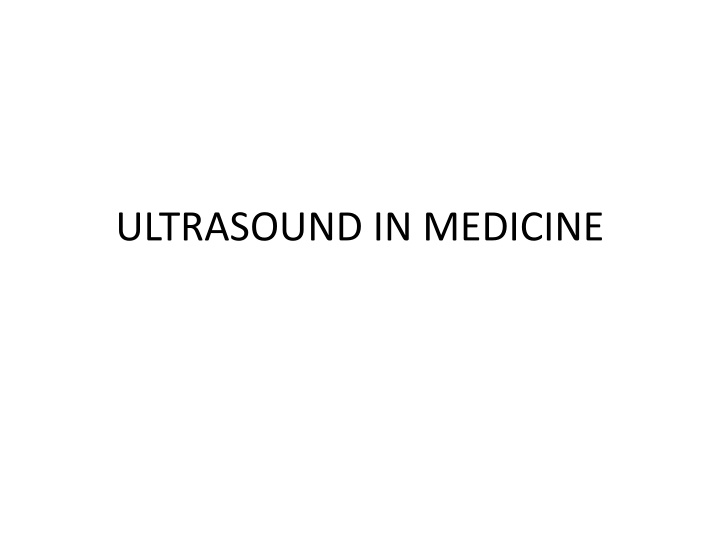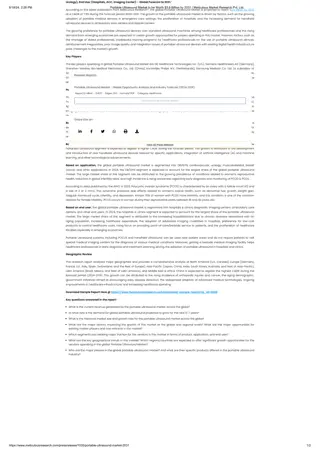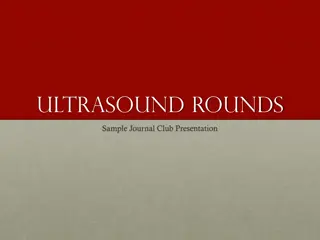ULTRASOUND IN MEDICINE
Ultrasonic waves play a crucial role in medicine for diagnostic imaging and surgical procedures. By utilizing high-frequency sound pulses and detecting echoes, detailed images of internal anatomy can be obtained, with widespread applications in obstetrics and neurosurgery. The technology allows for non-invasive examination of the developing fetus and precise removal of brain tumors through devices like the cavitron ultrasonic surgical aspirator. Understanding the principles of ultrasound and its various applications is essential in modern healthcare practices.
Uploaded on Feb 24, 2025 | 4 Views
Download Presentation

Please find below an Image/Link to download the presentation.
The content on the website is provided AS IS for your information and personal use only. It may not be sold, licensed, or shared on other websites without obtaining consent from the author.If you encounter any issues during the download, it is possible that the publisher has removed the file from their server.
You are allowed to download the files provided on this website for personal or commercial use, subject to the condition that they are used lawfully. All files are the property of their respective owners.
The content on the website is provided AS IS for your information and personal use only. It may not be sold, licensed, or shared on other websites without obtaining consent from the author.
E N D
Presentation Transcript
When ultrasonic waves are used in medicine for diagnostic purposes, high-frequency sound pulses are produced by a transmitter and directed into the body. As in sonar, reflections occur. They occur each time a pulse encounters a boundary between two tissues that have different densities or a boundary between a tissue and the adjacent fluid.
By scanning ultrasonic waves across the body and detecting the echoes generated from various internal locations, it is possible to obtain an image or sonogram of the inner anatomy. Ultrasonic imaging is employed extensively in obstetrics to examine the developing fetus. The fetus, surrounded by the amniotic sac, can be distinguished from other anatomical features so that fetal size, position, and possible abnormalities can be detected.
When ultrasound is used to form images of internal anatomical features or foreign objects in the body, the wavelength of the sound wave must be about the same size as, or smaller than, the object to be located. Therefore, high frequencies in the range from 1 to 15 MHz (1 MHz=1 megahertz=1 106Hz) are the norm. For instance, the wavelength of 5- MHz ultrasound is w=? ?=0.3 mm, if a value of 1540 m/s is used for the speed of sound through tissue. Hz is cycles in seconds. wavelength sound wave
If the object is smaller than 0.3 mm the corresponding wavelength must be higher than 5 MHz because the relation between frequency and wavelength is inversely proportional.
Ultrasound also has applications other than imaging. Neurosurgeons use a device called a cavitron ultrasonic surgical aspirator (CUSA) to remove brain tumors once thought to be inoperable.
Ultrasonic sound waves cause the slender tip of the CUSA probe to vibrate at approximately 23 kHz. The probe shatters any section of the tumor that it touches, and the fragments are flushed out of the brain with a saline solution. Because the tip of the probe is small, the surgeon can selectively remove small bits of malignant tissue without damaging the surrounding healthy tissue.
General properties of sound A sound is any wave travelling through the air or any medium which can be heard by human`s ear. Properties of sound waves: 1. Speed of sound is 340 m/s. 2. Longitudinal : oscillations are parallel to wave propagation; longitudinal wave: a particle displacement is parallel to direction of wave propagation.
The waves are compressed and expanded in the direction of wave
3. Speed of sound depends on temperature and how density of material that sound wave is.
frequency Range of frequencies that we hear is ( ). V=f , v=d/t V is speed of the sound wave F is frequency. is wavelength. D is distance, and t is time. What is the distance of a storm that is far a way than us ? V=343 m/s, f= 6 MHz, wavelength= 1 m.
loudness Loudness of sound is changing by volume of a device. Loudness or volume is a measure of amplitude of a wave.
stethoscope Stethoscope is an acoustic medical device that is used for listening internal sounds inside body that are emitted from heart, lung, blood flow in artier and vein, and colon.
ACOUSTIC IMPEDENCE Acoustic impedance (Z): it is a resistance by a system to the pressure that is caused by volumetric acoustic flow. Si unit for this impedance is Pa.s/ M3 Acoustic impedance of a material is equal to the product of density of the material by acoustic velocity. Z = x v Where density of material and v velocity of sound.























